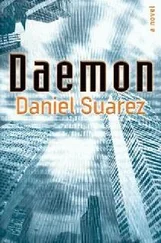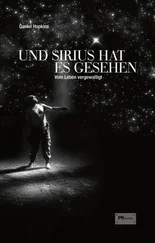It was only a few inches deep with no hatch mechanism visible. It had just appeared somehow. At the back of the opening was a glowing green light, with a small square socket next to it.
Grady then examined the tool in his hand. Its thin end was round and too large for the socket. He then looked into the eye at the other end of the tool and drew a painful breath before raising it with a weak, trembling hand. He held the eye in front of the light like an iris scanner.
A series of tones sounded. The tentacles all withdrew into the ceiling, and the bench-like cot sank into the floor without a trace. The lights dimmed. Suddenly what looked like computer screens appeared arrayed along the entire length of his cell wall—the same place where he’d seen his thoughts replayed.
The nearest of the new screens bore the label “Cell R483 Console. ” It listed several columns of stats apparently meant for maintenance personnel:
Elapsed Session Time: 1:87:61:78:392:303
Interrogatory Evolutions: 23,381
Parasagittal Valence: 210.9
Avg Trunk Voltage: 23.907kV
Hydrolyzer Ready State: 21ths
Barometric Pressure: 1.000123
Relative Humidity: 23.2%
Particulate Concentration: 0.00099ppm
…
There were hundreds of lines of similar stats arcing around the room, updating every few moments. None of it made immediate sense. But it did appear to be in English. As Grady lowered his quivering arm, he noticed that the motions of his hand made a pointer of some type move across the wall. He was apparently able to interact with the screen—and with the menus above them. He tapped at a menu labeled “Diagnostic Overrides” and noticed a series of submenus appear referring to “Life Support,” “Interrogatory Subsystems,” “Projection,” and much more.
Were the Resistors just assuming that the geniuses in these cells could figure all this shit out? Grady didn’t feel particularly ingenious at the moment.
He slumped back down and rested with his back against the wall. That’s when he noticed that the worm was once again projecting information onto the wall. He glanced up to see the following message waiting for him:
Nao waike taojian v3.8.80—Kuozhan zi xito ng jishu caozuo sho uce
Cerebral Interrogatory Enclosure v3.8.80—Extended Subsystem Technical Operations Manual
Церебральный Корпус Люкс v3.8.80—подсистема расширенного Технического руководства операции
Cerebral Caja suite v3.8.80—Manual extendido Subsistema de Operaciones Técnicas
Boîtier cérébrale Suite v3.8.80—Manuel des opérations techniques du sous-système étendu
Grady let out a laugh—before catching himself from the pain in his abdomen.
Okay. Go slow.
“Thanks, Junior.”
CHAPTER 9
The Necessary Lie
It took some time forGrady to relax around his wormlike companion. It bore enough of a resemblance to the monstrous tentacles of his cell’s AI to be disturbing. But then Grady guessed “Junior” had been cannibalized from those restraint tentacles. In fact, there was something encouraging about the fact that the BTC’s own equipment could be subverted. He wanted to learn how to do that.
And in any event Grady began to enjoy Junior’s company. The device reacted to human speech by rearing up on its coil attentively, not unlike a curious dog. Like a dog it didn’t seem to understand speech, but it did respond to tone. High-pitched talk seemed to encourage it. Low-pitched scolding caused it to curl in a ball for several minutes. It also followed him around, slithering across the floor. And it didn’t seem to require charging. Somehow battery life was a solved problem to the BTC. If indeed it did use batteries.
By trial and error Grady learned how to activate and deactivate Junior’s projector lights by tapping its feelers. The screen it projected on any nearby surface was touch-sensitive as well, and before long Grady had settled in to read the seemingly endless technical manual for the “Cerebral Interrogatory Enclosure,” or CIE—which was apparently his cell and the AI that managed it.
After the sensory starvation of the past few months, Grady’s appetite for information was ravenous. Poring through the manual, he soon learned how to navigate the deeper diagnostic and maintenance screens of the CIE.
The moment Grady switched his cell from umbilical to manual life support represented a fundamental shift in his perspective. It was a simple diagnostic override, but when he deactivated the umbilicus, there was another audible chime as lavatory and sink facilities “grew” out of the wall. The toilet and sink consisted of the same featureless gray material as the walls themselves, but when he held his hand in front of the stylized faucet, clean water poured out. He now had some measure of control over his body again. There was apparently a bathing system as well, but he hadn’t found the options for that yet.
The documentation had warned Grady that he needed to take care restarting his digestive system. He hadn’t taken anything but predigested slurry in months. Still, he figured he could risk tasting some water. He watched, fascinated, as it flowed over his hands. The natural hydrodynamic laws governing its surface resistance and pooling kept him mesmerized. So long since he’d seen those natural laws. Or any natural laws. His synesthesiac mind reveled in the stimulation.
Then Grady tasted the water. Felt it flow down his throat like sunlight. He was coming alive again. He splashed the water over his face and sighed in satisfaction. No towels to dry himself, though—and he was still naked. But it didn’t bother him. He stood and felt the cool water from his face run in rivulets down his neck and body.
He then walked his cell in relieved contemplation, leaving moist footprints. It was the first time in a long time that he could recall not having those nightmarish tentacles hanging overhead. The pain in his abdomen notwithstanding, it was good to walk freely.
That’s when he bumped into a fine black filament hanging down from the ceiling in the center of his cell. It was right above where his cot had been. At first he thought it was—of all things—a spider hanging on a silk thread. But as he moved carefully around it, he could see that the nodule at its end was some sort of connector. Inorganic. It looked like a microscopic wire. He examined it carefully before taking hold of the end.
The black thread it hung from felt similar to the carbon fiber threads inserted into his brain—at least as he remembered them. Touching his head to confirm it didn’t seem like a great idea.
He pulled on the long thread, but it didn’t budge. It was incredibly strong and began cutting into his hand. He let go quickly. No blood, but the beginnings of a paper cut.
He stared up at the domed ceiling. The thread was so thin that it became invisible not far above him. What was this thing?
The mystery had to remain for the moment. As good as he felt right now, Maslow’s hierarchy of needs hadn’t quite been handled. Sooner or later food would become a necessity. He had to figure out how to get it before it became an emergency.
Grady got back to navigating the deeper system menus of his cell’s operating system. From this he accessed a diagram of the entire CIE and soon realized that the living area was just part of a larger self-contained interrogation system. The AI hadn’t lied about that much at least. His cell appeared to have no direct connection—and no entrance or exit to the outside world. He was like a ship in a bottle. Hard to say how they’d gotten him in here because except for a two-inch-diameter pressure-regulation conduit the place was fully sealed. In rock? Nanomaterials? No details.
Читать дальше












